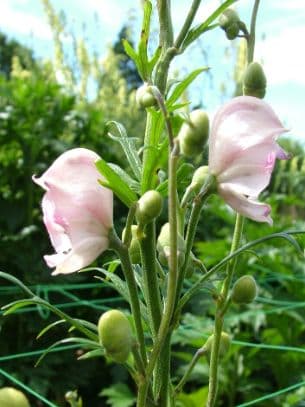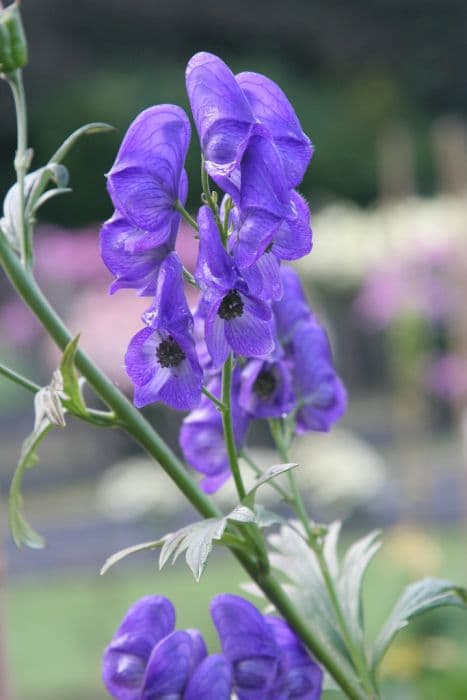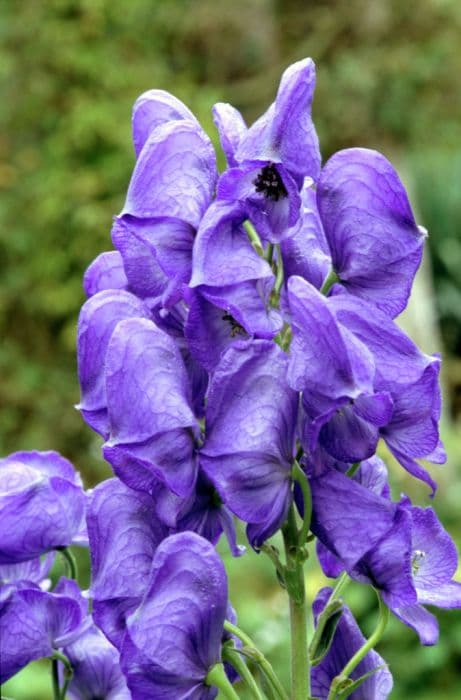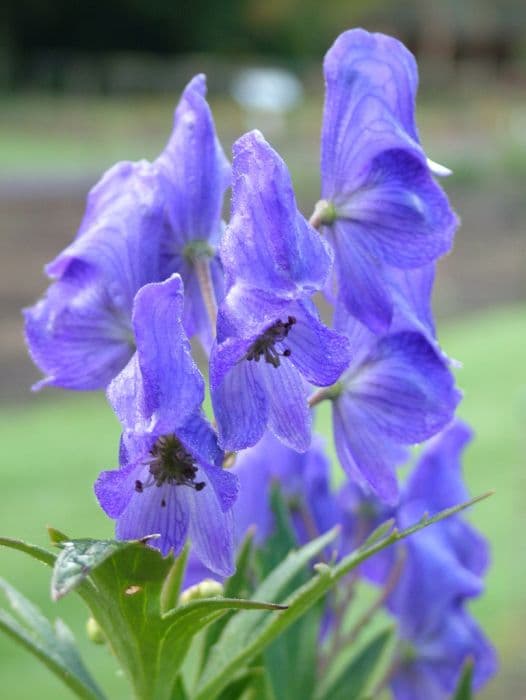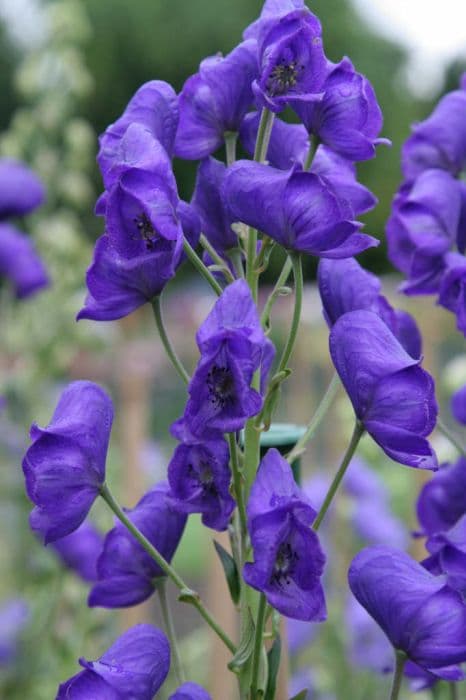Clematis Clematis 'Madame Grangé' (LL)

ABOUT
Clematis 'Madame Grangé' is a stunning climbing plant known for its impressively large flowers. The blooms are the most eye-catching feature, boasting a robust, vibrant purple or violet color that gives them a regal appearance. Each flower consists of six to eight sepals, which are often mistaken for petals. These sepals are broad, overlapping, and have a plush, velvety texture, adding to the luxurious feel of the plant. The center of each flower showcases a tuft of creamy-yellow stamens, which create a beautiful contrast against the deep purple hues of the sepals. This color combination makes the blossoms pop and draws attention in any garden setting. The leaves of the Clematis 'Madame Grangé' are green, with a glossy sheen that complements the floral display perfectly. They are divided into leaflets that spread out gracefully, providing a lush backdrop for the flowers. The plant uses its leaf stalks to twine around supports, allowing it to climb and showcase its beauty vertically. Throughout its blooming season, this clematis variety offers a profusion of flowers, creating a spectacular display that can enliven a trellis, arbor, or fence. The overall visual effect of the Clematis 'Madame Grangé' is one of elegance and drama, making it a beloved choice for gardeners looking to add a touch of sophistication and colorful flair to their outdoor spaces.
About this plant
 Names
NamesFamily
Ranunculaceae.
Synonyms
Madame Grangé Clematis, Clematis 'Madame Grangé', Leather Flower.
Common names
Clematis 'Madame Grangé' (LL)
 Toxicity
ToxicityTo humans
Clematis, including the 'Madame Grangé' variety, contains compounds that can be toxic if ingested. These compounds can cause gastrointestinal upset, such as nausea, vomiting, and diarrhea. In some cases, it may also lead to mouth irritation and ulcers. It is important to handle the plant with care and ensure that it is not consumed by children, who might be tempted by its showy flowers.
To pets
Clematis is also toxic to pets, which can experience symptoms similar to those in humans if they ingest parts of the plant. Symptoms of clematis poisoning in pets can include drooling, diarrhea, vomiting, and at times, weakness or lethargy. It is vital to keep this plant out of reach of pets and to seek veterinary care immediately if you suspect your pet has consumed any part of a clematis plant.
 Characteristics
CharacteristicsLife cycle
Perennials
Foliage type
Deciduous
Color of leaves
Green
Flower color
Violet
Height
6-8 feet (1.8-2.4 meters)
Spread
3-4 feet (0.9-1.2 meters)
Plant type
Climber
Hardiness zones
4
Native area
China
Benefits
 General Benefits
General Benefits- Ornamental Appeal: Clematis 'Madame Grangé' provides aesthetic beauty to gardens with its attractive flowers.
- Vertical Interest: As a climbing vine, it can be used to add height to garden designs, covering structures like trellises, fences, and walls.
- Seasonal Color: It produces colorful blooms that can enhance the visual interest of a landscape throughout its blooming season.
- Pollinator Friendly: The flowers can attract bees and butterflies, which are beneficial for pollination in the garden.
- Versatility: Clematis 'Madame Grangé' is suitable for various garden styles, including cottage gardens and formal landscapes.
- Privacy: When grown on fences or trellises, it can provide a natural privacy screen.
- Shade Provider: When trained over pergolas or arbors, it can offer a shaded area in the garden.
- Ease of Pruning: It can be pruned according to different pruning groups, which allows control over its size and shape.
 Medical Properties
Medical PropertiesThis plant is not used for medical purposes.
 Air-purifying Qualities
Air-purifying QualitiesThis plant is not specifically known for air purifying qualities.
 Other Uses
Other Uses- Clematis 'Madame Grangé' can be used as a natural dye source for fabrics, providing shades of green to yellow depending on the mordant used.
- When dried, the vines of Clematis can be woven into small baskets or decorative items, showcasing its artistic potential beyond the garden.
- The seed heads of Clematis 'Madame Grangé' can be used in dried floral arrangements, adding texture and interest long after the blooming season.
- As a climbing plant, Clematis can be trained over unsightly structures, such as old fences or sheds, to beautify otherwise unattractive areas.
- Clematis vines can be used as a natural screen or privacy barrier when grown on trellises in close proximity.
- Gardeners may utilize the Clematis 'Madame Grangé' plant markers to create an organized and visually appealing layout in the garden.
- Photographers and artists may seek out the intricate blossoms of the Clematis 'Madame Grangé' as subjects for their work, capturing its beauty in various mediums.
- The plant's climbing nature makes it suitable for educational projects on plant growth habits and support structures in schools or community gardens.
- Clematis 'Madame Grangé' can also be used in permaculture designs, contributing vertical diversity to a multilayered garden ecosystem.
- Some people may collect the seed heads of Clematis 'Madame Grangé' for ornamental purposes, stringing them into unconventional jewelry or mobiles.
Interesting Facts
 Feng Shui
Feng ShuiThe Clematis is not used in Feng Shui practice.
 Zodiac Sign Compitability
Zodiac Sign CompitabilityThe Clematis is not used in astrology practice.
 Plant Symbolism
Plant Symbolism- Ingenuity and Cleverness: Given its ability to climb and adapt to its surroundings, the clematis often symbolizes resourcefulness and intellect.
- Mental Beauty: With its intricate and striking flowers, clematis can represent the beauty of the mind and thoughts, as well as the value of inner beauty.
- Artistic Inspiration: Many artists and creatives view the clematis as a symbol of creativity and the muse due to its dramatic and showy blooms.
- Traveler’s Joy: One of the common names for clematis is "Traveler's Joy," which reflects its heritage as a plant often found along rural footpaths, symbolizing joy and protection during travel.
- Aspirational Growth: The growth pattern of clematis, reaching upwards and twining, symbolizes aspiration and striving for higher goals.
 Water
WaterThe Clematis 'Madame Grangé', commonly known as Queen of the Vines, prefers to be watered deeply rather than frequently. It's best to provide the plant with about 1 gallon of water once a week, allowing the soil to dry out slightly between waterings. During the growing season in spring and summer, water needs may increase, so it's advised to check the soil moisture more frequently. Over the hot summer months, an additional half gallon midweek might be necessary to maintain consistent soil moisture. In winter, reduce watering as the plant goes dormant, ensuring the soil does not become waterlogged.
 Light
LightThe Queen of the Vines flourishes in a location where it receives about six hours of sunlight a day. Ideally, it should be planted in a spot that gets morning sun and afternoon shade to protect it from the intense heat of the day. A north or east-facing position would meet these light requirements well.
 Temperature
TemperatureThe Queen of the Vines does best in temperatures ranging between 40 and 80 degrees Fahrenheit. It can survive a temperature dip down to about 20 degrees Fahrenheit but should be shielded from harsh winter winds. During the active growing season, the ideal temperature range is between 60 and 70 degrees Fahrenheit to promote healthy growth.
 Pruning
PruningPruning the Queen of the Vines encourages strong growth and enhances flowering. For this Clematis, pruning should be done in late winter or early spring, removing any dead or weak stems. Pruning just above strong leaf buds will stimulate new growth. This type of clematis flowers on old wood, so the pruning should be light, simply shaping the plant and maintaining health.
 Cleaning
CleaningAs needed
 Soil
SoilClematis, including 'Madame Grangé', thrives in fertile, well-draining soil with a pH close to neutral, around 6.5-7.0. An ideal soil mix for clematis should include composted organic matter and possibly a bit of balanced fertilizer. Adding a layer of mulch helps retain moisture and keeps roots cool.
 Repotting
RepottingClematis 'Madame Grangé' typically does not require frequent repotting and can often be left in the same pot or location for several years. It is generally recommended to repot only when the plant shows signs of distress or outgrowing its current space, which may happen every 3-5 years.
 Humidity & Misting
Humidity & MistingClematis 'Madame Grangé' prefers outdoor conditions where humidity is usually not a critical factor. It is adaptable to a wide range of humidity levels found in garden settings.
 Suitable locations
Suitable locationsIndoor
Grow in bright indirect light with support for climbing.
Outdoor
Plant in sun/part shade; provide support for climbing; mulch roots.
Hardiness zone
4-9 USDA
 Life cycle
Life cycleClematis 'Madame Grangé', also known as Leatherflower, begins its life cycle as a seed, which upon germination develops a root system and shoots. The plant enters a vegetative stage where it grows stems and leaves vigorously, utilizing its climbing habit to reach sunlight. As it matures, Leatherflower produces distinctive, large, and colorful flowers, usually from late spring to early fall, which is its reproductive stage. After pollination, often by insects attracted to its blooms, the plant produces seed heads that contain seeds for dispersal. Once the growing season ends, the Clematis 'Madame Grangé' may die back to the ground in colder climates, entering a period of dormancy through the winter. With the return of warmer temperatures, the plant breaks dormancy, regrows from its perennial woody base, and repeats the cycle.
 Propogation
PropogationPropogation time
Spring-Early Summer
The most popular method of propagating the Clematis 'Madame Grangé', also known as the Clematis, is through softwood cuttings. This method is typically carried out in early summer when the plant’s new growth is mature enough yet still in its softwood stage. To perform this type of propagation, one would cut a 4 to 6 inch (which is approximately 10 to 15 centimeters) section of the vine, ensuring that there are at least two sets of leaves or nodes. The lower set of leaves is removed and the cut end of the stem is dipped in rooting hormone before being planted in a well-draining soil mix. The cutting should be kept moist and in a warm environment with indirect light until roots develop, which usually takes a few weeks to a couple of months. Once rooted, the young plants can be potted up or eventually moved into the garden.

